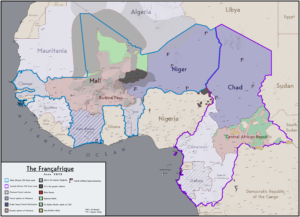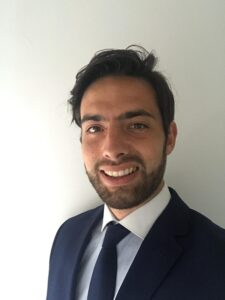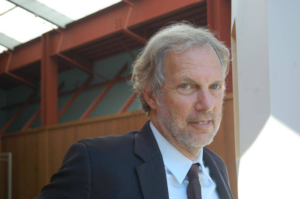How Can We Understand The Passage Of Time?

Photo: en.wiki.eng
Recent developments in the study of human prehistory hold clues about our times, our world, and ourselves.
We can all agree that most people want to know about their origins—spanning from their family and ancestral history and even, occasionally, deeper into the evolutionary story.
Lately, this desire has become more palpable in society at large and even taken on urgent tones as we drift away from the lifestyle patterns and traditions that humans relied on for millions of years toward a technoculture that is highly addictive, and hard to understand or break away from.
But the desire to know the deep past doesn’t translate so easily into understanding, especially since the information we encounter is necessarily filtered by our own sociohistorical context. One of the biggest obstacles to gaining a true understanding of the unfolding of humanity’s past is the way that modern societies foster a superficial understanding of the passage of time.
To delve deeply into human prehistory requires adopting a different kind of chronological stance than most of us are accustomed to—not just a longer period of time, but also a sense of evolution infused by the operating rules of biology and its externalities, such as technology and culture. But exploring the past enables us to observe long-term evolutionary trends that are also pertinent in today’s world, elucidating that novel technological behaviors that our ancestors adopted and transformed into culture were not necessarily better, nor more sustainable over time.
Nature is indifferent to the recency of things: whatever promotes our survival is passed on and proliferated through future generations. This Darwinian axiom includes not only anatomical traits, but also cultural norms and technologies.
Shared culture and technologies give people the ongoing sensation of the synchronization of time with each other. The museums and historical sites we visit, as well as the books and documentaries on the human story, overwhelmingly present the past to their audiences through simultaneous or synchronized stages that follow a kind of metric system of conformity in importance. Human events are charted along the direction of either progress or failure.
The archeological record shows us, however, that even though human evolution appears to have taken place as a series of sequential stages advancing our species toward “progress,” in fact, there is no inherent hierarchy to these processes of development.
This takes a while to sink in, especially if you’ve been educated within a cultural framework that explains prehistory as a linear and codependent set of chronological milestones, whose successive stages may be understood by historically elaborated logical systems of cause and effect. It takes an intellectual leap to reject such hierarchical constructions of prehistory and to perceive the past as a diachronous system of nonsynchronous events closely tied to ecological and biological phenomena.
But this endeavor is well worth the effort if it allows people to recognize and make use of the lessons that can be learned from the past.
If we can pinpoint the time, place, and circumstances under which specific technological or social behaviors were adopted by hominins and then follow their evolution through time, then we can more easily understand not only why they were selected in the first place, but also how they evolved and even what their links with the modern human condition may be.
Taking on this approach can help us understand how the reproductive success of our genus, Homo, eventually led up to the emergence of our own species, sapiens, through a complex process that caused some traits to disappear or be replaced, while others were transformed or perpetuated into defining human traits.
While new discoveries are popularizing the exciting new findings dating as far back as the Middle Paleolithic, the public is typically presented with a compressed prehistory that starts at the end of the last ice age some 12,000 years ago. This is understandable, since the more recent archeological register consists of objects and buildings that are in many ways analogous to our own patterns of living. Ignoring the more distant phases of the shared human past, however, has a wider effect of converting our interpretations of prehistory into a sort of timeless mass, almost totally lacking in chronological and even geographical context. Read more
Artificial Intelligence: Profit Versus Freedom

Richard D. Wolff
Artificial Intelligence (AI) presents a profit opportunity for capitalists, but it presents a crucial choice for the working class. Because the working class is the majority, that crucial choice confronts society as a whole. It is the same profit opportunity/social choice that was presented by the introduction of robotics, computers, and indeed by most technological advances throughout capitalism’s history. In capitalism, employers decide when, where, and how to install new technologies; employees do not. Employers’ decisions are driven chiefly by whether and how new technologies affect their profits.
If new technologies enable employers to profitably replace paid workers with machines, they will implement the change. Employers have little or no responsibility to the displaced workers, their families, neighborhoods, communities, or governments for the many consequences of jobs lost. If the cost to society of joblessness is 100 whereas the gain to employers’ profits is 50, the new technology is implemented. Because the employers’ gain governs the decision, the new technology is introduced, no matter how small that gain is relative to society’s loss. That is how capitalism has always functioned.
A simple arithmetic example can illustrate the key point. Suppose AI doubles some employees’ productivity. During the same work time, they produce twice as much as before the use of AI. Employers who use AI will then fire half of their employees. Such employers will then receive the same output from the remaining 50 percent of their employees as before the introduction of AI. To keep our example simple, let’s assume those employers then sell that same output for the same price as before. Their resulting revenues will then likewise be the same. The use of AI will save the employers 50 percent of their former total wage bills (less the cost of implementing AI) and those savings will be kept by employers as added profit for them. That added profit was an effective incentive for the employer to implement AI.
If we imagine for a moment that the employees had the power that capitalism confers exclusively on employers, they would choose to use AI in an altogether different way. They would use AI, fire no one, but instead cut all employees’ working days by 50 percent while keeping their wages the same. Once again keeping our example simple, this would result in the same output as before the use of AI, and the same price for the goods or services and revenue inflow would follow. The profit margin would remain the same after the use of AI as before (minus the cost of implementing the technology). The 50 percent of employees’ previous workdays that are now available for their leisure would be the benefit they accrue. That leisure—freedom from work—is their incentive to use AI differently from how employers did.
One way of using AI yields added profits for a few, while the other way yields added leisure/freedom to many. Capitalism rewards and thus encourages the employers’ way. Democracy points the other way. The technology itself is ambivalent. It can be used either way.
Thus, it is simply false to write or say—as so many do these days—that AI threatens millions of jobs or jobholders. Technology is not doing that. Rather the capitalist system organizes enterprises into employers versus employees and thereby uses technological progress to increase profit, not employees’ free time.
Throughout history, enthusiasts celebrated most major technological advances because of their “labor-saving” qualities. Introducing new technologies would deliver less work, less drudgery, and less demeaning labor. The implication was that “we”—all people—would benefit. Of course, capitalists’ added profits from technical advances no doubt brought them more leisure. However, the added leisure new technologies made possible for the employee majority was mostly denied to them. Capitalism—the profit-driven system—caused that denial. Read more
Is This The End Of French Neo-Colonialism In Africa?

Françafrique – en.wikipedia.org
In Bamako, Mali, on September 16, the governments of Burkina Faso, Mali, and Niger created the Alliance of Sahel States (AES). On X, the social media platform formerly known as Twitter, Colonel Assimi Goïta, the head of the transitional government of Mali, wrote that the Liptako-Gourma Charter which created the AES would establish “an architecture of collective defense and mutual assistance for the benefit of our populations.” The hunger for such regional cooperation goes back to the period when France ended its colonial rule. Between 1958 and 1963, Ghana and Guinea were part of the Union of African States, which was to have been the seed for wider pan-African unity. Mali was a member as well between 1961 and 1963.
But, more recently, these three countries—and others in the Sahel region such as Niger—have struggled with common problems, such as the downward sweep of radical Islamic forces unleashed by the 2011 North Atlantic Treaty Organization (NATO) war on Libya. The anger against the French has been so intense that it has provoked at least seven coups in Africa (two in Burkina Faso, two in Mali, one in Guinea, one in Niger, and one in Gabon) and unleashed mass demonstrations from Algeria to the Congo and most recently in Benin. The depth of frustration with France is such that its troops have been ejected from the Sahel, Mali demoted French from its official language status, and France’s ambassador in Niger (Sylvain Itté) was effectively held “hostage”—as French President Emmanuel Macron said—by people deeply upset by French behavior in the region.
Philippe Toyo Noudjenoume, the President of the West Africa Peoples’ Organization, explained the basis of this cascading anti-French sentiment in the region. French colonialism, he said, “has remained in place since 1960.” France holds the revenues of its former colonies in the Banque de France in Paris. The French policy—known as Françafrique—included the presence of French military bases from Djibouti to Senegal, from Côte d’Ivoire to Gabon. “Of all the former colonial powers in Africa,” Noudjenoume told us, “it is France that has intervened militarily at least sixty times to overthrow governments, such as [that of] Modibo Keïta in Mali (1968), or assassinate patriotic leaders, such as Félix-Roland Moumié (1960) and Ernest Ouandié (1971) in Cameroon, Sylvanus Olympio in Togo in 1963, Thomas Sankara in Burkina Faso in 1987 and others.” Between 1997 and 2002, during the presidency of Jacque Chirac, France intervened militarily 33 times on the African continent (by comparison, between 1962 and 1995, France intervened militarily 19 times in African states). France never really suspended its colonial grip or its colonial ambitions.
Breaking the Camel’s Back
Two events in the past decade “broke the camel’s back,” Noudjenoume said: the NATO war in Libya, led by France, in March 2011, and the French intervention to remove Koudou Gbagbo Laurent from the presidency of Côte d’Ivoire in April 2011. “For years,” he said, “these events have forced a strong anti-French sentiment, particularly among young people. It is not just in the Sahel that this feeling has developed but throughout French-speaking Africa. It is true that it is in the Sahel that it is currently expressed most openly. But throughout French-speaking Africa, this feeling is strong.”
Mass protest against the French presence is now evident across the former French colonies in Africa. These civilian protests have not been able to result in straight-forward civilian transitions of power, largely because the political apparatus in these countries had been eroded by long-standing, French-backed kleptocracies (illustrated by the Bongo family, which ruled Gabon from 1967 to 2023, and which leeched the oil wealth of Gabon for their own personal gain; when Omar Bongo died in 2009, French politician Eva Joly said that he ruled on behalf of France and not of his own citizens). Despite the French-backed repression in these countries, trade unions, peasant organizations, and left-wing parties have not been able to drive the upsurge of anti-French patriotism, though they have been able to assert themselves
France intervened militarily in Mali in 2013 to try to control the forces that it had unleashed with NATO’s war in Libya two years previously. These radical Islamist forces captured half of Mali’s territory and then, in 2015, proceeded to assault Burkina Faso. France intervened but then sent the soldiers of the armies of these Sahel countries to die against the radical Islamist forces that it had backed in Libya. This created a great deal of animosity among the soldiers, Noudjenoume told us, and that is why patriotic sections of the soldiers rebelled against the governments and overthrew them. Read more
Breaking Europe’s Hold On Football

John P. Ruehl – Source: Independent Media Institute
09-15-2023 ~ Initiatives from Saudi Arabia and the United States continue to put pressure on Europe’s traditional stranglehold over FIFA.
The 2022 FIFA World Cup in Qatar brought together nations from around the world, and 1.5 billion people tuned in to watch the final. But while soccer is a source of local pride, passion, and personal and community identity globally, its official governing institution is headquartered in Europe. Founded in Paris in 1904 and now based in Switzerland, the Fédération Internationale de Football Association (FIFA) oversees international soccer promotion and development, from rule changes to hosting rights for major tournaments.
The Union of European Football Associations (UEFA), alongside England’s Premier League (EPL), Germany’s Bundesliga, Spain’s LaLiga, Italy’s Serie A, and France’s Ligue 1, play significant roles in global soccer and generate substantial revenue for FIFA. European clubs and national teams attract top talent, and through “sports diplomacy,” can project their cultural, political, and economic interests to the world and influence FIFA.
This dominance has long been a source of criticism. African teams in 1966 organized boycotts to protest their lack of representation at the World Cup. Even UEFA and João Havelange, president of FIFA from 1974 to 1998, became increasingly critical of each other, while Havelange’s successor, Sepp Blatter, also criticized FIFA’s Eurocentric influence in 2015.
Recently, this strain of critique has become even more apparent. During the 2022 World Cup in Qatar, European teams were rebuked by FIFA to abandon plans to wear pro-LGBT armbands, while UEFA-affiliated teams and FIFA clashed over Qatar’s human rights record in the lead-up to the tournament. But throughout 2023, Europe’s traditional dominance has been challenged by notable developments in Saudi Arabia and the United States.
Saudi Arabia’s Vision 2030, announced in 2016, aims to diversify its economy and attract foreign investment. While hosting and sponsoring motorsports, golf, boxing, and other sports tournaments form part of this, soccer serves as the cornerstone of Riyadh’s attempts to portray and promote the country. This charm offensive has drawn Western allegations of “sportswashing,” wherein sports are used to improve a country’s public image and divert attention from negative actions.
Like other Gulf States, Saudi Arabia has purchased major European teams in recent years. Saudi Arabia’s Public Investment Fund acquired the EPL’s Newcastle United in 2021, and Sheffield United, bought by the Saudis in 2013, will again play in the EPL in the 2023-24 season. The Saudis also reportedly made a multibillion-dollar bid to buy the EPL’s Chelsea, while tournaments like the Supercoppa Italiana and Spanish Super Cup are increasingly held in Saudi Arabia. Read more
A Mass Climate Mobilization Is Taking Place Sunday. Here’s Why It’s Urgent.

Robert Pollin
Economist Robert Pollin analyzes the state of the global green transition in the lead-up to Sunday’s mass protest.
A UN climate report ahead of the upcoming COP28 summit says that governments are failing to cut emissions fast enough for the planet to avoid an unmitigated disaster and calls in turn for the phasing out of fossil fuels. In the wake of the hottest summer on record, climate advocates have organized a “March to End Fossil Fuels” in New York City as part of the wave of global mobilizations with the aim of putting an end to the poisons that are killing the planet. The action will take place Sunday, September 17.
Amid this crucial mobilization, the climate movement is working hard to expose the roots of this crisis and chart an alternate course, wrestling with questions such as: Why do governments continue to subsidize fossil fuels? Aside from the obvious resistance of the fossil fuel industry, what are the economic and technological challenges we would face by moving to a post-fossil fuel future? How do we actually get to zero emissions?
Robert Pollin, one of the world’s leading progressive economists and an expert on the macroeconomics of climate change and energy, tackles these questions in an extensive and exclusive interview for Truthout. Pollin is distinguished professor of e conomics and co-director of the Political Economy Research Institute (PERI) at the University of Massachusetts Amherst. He has published scores of books and articles on jobs and macroeconomics, labor markets, wages and poverty, and environmental and energy economics. He was selected by Foreign Policy Magazine as one of the “100 Global Thinkers for 2013.” His latest book, coauthored with Noam Chomsky, is Climate Crisis and the Global Green New Deal: The Political Economy of Saving the Planet.
C. J. Polychroniou: On Wednesday, September 6, the European Copernicus Institute reported that the summer of 2023 was the hottest ever recorded in history by a large margin, prompting in turn UN Secretary-General António Guterres to issue a statement saying “climate breakdown has begun.” And speaking of the UN, on Friday, September 8, it released an assessment of the progress on cutting emissions in which it said that countries are failing to make good on their commitments to curb emissions and that, subsequently, “there is a rapidly closing window of opportunity to secure a livable and sustainable future for all.”
First, what’s the current picture of energy-related carbon dioxide (CO2) emissions and that of renewable energy, respectively, and why is it that eight years after the Paris Agreement the world is still falling short of its climate goals?
Robert Pollin: To have any chance of moving onto a viable global climate stabilization path, the single most critical project at hand is straightforward. It is to phase out the consumption of oil, coal and natural gas, so that, by 2050, fossil fuel consumption for producing energy will have fallen to zero. This is because producing and burning fossil fuels to produce energy is responsible for about 90 percent of all CO2 emissions.
As of the most recent data from the International Energy Agency (IEA), the leading mainstream organization focused on global energy market conditions, global CO2 emissions were at around 36 billion tons in 2021. This represents a roughly 70 percent emissions increase since 1990 and a 14 percent increase just since 2010. More to the point, according to the IEA’s estimates for future emissions under two alternative realistic scenarios — what they term as their “stated policies” and “announced pledges” scenarios — emissions will fall barely at all by 2030 and will not come close to achieving the zero emissions target by 2050.
The IEA does also develop a scenario through which the world can reach zero emissions by 2050. The difference between the IEA’s stated policies and announced pledges scenarios relative to their net zero emissions by 2050 scenario is what the IEA demurely terms an “ambition gap.” The question for getting to zero emissions is therefore to figure out how to close this “ambition gap.”
Closing this ambition gap must, of course, recognize that people do still need to consume energy to light, heat and cool buildings, to power cars, buses, trains and airplanes, and to operate computers and industrial machinery, among other uses. As such, to make progress toward climate stabilization requires a viable alternative to the existing fossil fuel dominant infrastructure for meeting the world’s energy needs. Read more
Colombia, From The Guerrilla To The Ballot Box
A conversation with Pastor Alape, former guerrilla mayoral candidate for the Comunes Party.
On May 4, 2023, during the International Summit on Nonviolence held in Antioquia, Colombia, a handshake shocked those who were present. The handshake was between two men with vastly different histories. One of the men was Daniel Gaviria, whose father—Guillermo Gaviria, former governor of Antioquia—was killed in 2003 when he was a hostage of the Revolutionary Armed Forces of Colombia-People’s Army (FARC-EP). The other man was Pastor Alape, former commander of the FARC-EP. Gaviria said that the handshake took place because Pastor Alape was “taking steps toward nonviolence.” “That gives me confidence and leads me to extend forgiveness to him,” said Gaviria.
Pastor Alape commanded one of the FARC-EP’s regions and was part of its highest body, the Estado Mayor Central. FARC-EP, founded in 1964, signed a peace agreement with the Colombian state in 2016. It was then transformed into the Comunes Party, comprising former guerrillas and members from various social movements. This party, which has contested elections, focuses its attention on the need to implement the peace agreement and advance the cause of social justice in Colombia. One of the lingering problems in the country is the full incorporation of former guerrilla fighters into the country’s social and political life.
Not long after the handshake, we spoke to Pastor Alape about the process of reintegration. He told us that as part of this process, he has decided to be the first former member of the national leadership of the FARC-EP to run for regional elections. Pastor Alape is running to be the mayor of Puerto Berrío in Antioquia, where he grew up. In his new civilian life, the former combatant decided to combine the name given to him by his parents (Félix Antonio Muñoz Lascarro) with the name given to him by the guerrilla struggle (Pastor Alape) and be called Pastor Lisandro Alape Lascarro. Earlier in July, he said that he joined the FARC-EP to “change the country with a lead” and now through Comunes he wants to “change it with the votes.”
Resistance of a Legal Kind
In 1974, Pastor Alape—at the age of 15—joined the Communist Youth. That year, a pact that was formed in 1958 between the Liberal and the Conservative parties to govern together as a National Front ended. It was this political turmoil that led to the armed struggle of the FARC-EP and other groups in the 1960s. But, in 1974, the Colombian Communist Party (PCC)—which had been underground—became politically active again. His work in the Communist Youth from that time, Pastor Alape told us, allowed for his “political formation through legal resistance.” This time was short-lived, and when the violence restarted, Pastor Alape joined the FARC-EP.
After 53 years of armed resistance, the warring parties signed a historic peace agreement in Havana in 2016 and Comunes entered the electoral domain. As part of the peace agreement, to incorporate Comunes into legal politics, the party is represented in Congress by 10 members. But it has thus far not been able to win many seats in the different local and regional bodies. In the October 29 regional elections, Comunes will contest 145 seats, including for the mayor’s office in Puerto Berrío, which Pastor Alape is running for.
A Community That Survives
“I have not been very fond of electoral politics,” Alape told us. “But when I arrived in the town of Puerto Berrío and met with old and new friends and family, these interactions gave me the impetus to try and use the political system to initiate state action on behalf of marginalized communities.”
Puerto Berrío or El Pueblo, as Pastor Alape calls it, is a small municipality of around 51,000 people in the province of Antioquia, which is located on the banks of the Magdalena River. On December 17, 1979, Pastor Alape left his home on a small boat on this very river to go to Matarredonda in Chaparral (Tolima) to join the FARC-EP. Now, he walks along the riverbanks and campaigns to become its mayor. Read more


